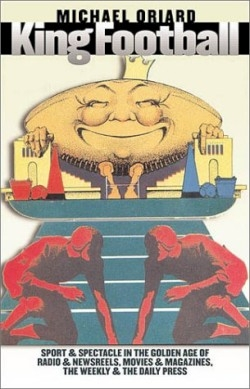King Football
Sport and Spectacle in the Golden Age of Radio and Newsreels Movies and Magazines the Weekly and the Daily Press
“Football is everything America is—fast, young, colorful, complex, efficient, aggressive,” wrote Life magazine in November 1955. “Sitting in the stadium, watching the pretty coeds, singing the stirring old fight songs and yelling themselves hoarse (sometimes softening the chill of the air with a quick nip), the spectators could only agree the whole spectacle furnished a fine reason for being alive.”
This excerpt, of course, tells the reader more about Life magazine’s assumptions about America and Americans than it does about football. Those assumptions are precisely the focus of this new book. The author, a former collegiate and professional football player himself and now a professor of literature at Oregon State University, traces the growth of football in the American media from the 1920s to the 1950s. The result is more a cultural history book than a sports book, as much a history of the media as of football.
Oriard offers a rich and comprehensive survey of the topic, dense with examples and citations, including 100 pages of appendices, notes, and bibliographic citations. The book also features thirty—eight illustrations such as football—related covers from the Saturday Evening Post, American Boy, and Collier’s.
Oriard asserts that football in this era came to symbolize “an entire social and domestic world, idealizing a certain model of American middle-class life.” He explores how football (as well as its representation in the media) was shaped by—and helped to shape—the values of the society around it. There are chapters on class, race, ethnicity, and masculinity. Particularly interesting is Oriard’s study of the evolving role of the coach. Tied up with cultural notions of patriarchal authority and masculinity, the idea of the coach changed as the country changed. The archetypal roles of the kindly old “Pop” and the dictatorial “Biff” that Oriard describes were in part creations of the pre-World War II media, which became increasingly anachronistic after the war.
The author has written an earlier book, Reading Football: How the Popular Press Created an American Spectacle, which follows football from its birth in the nineteenth century until 1920. King Football is an important successor, tracing the sport’s evolution in the media right up to 1960, at the doorstep of the television age. In a country where sports continue to be deeply ingrained in the national identity, this is a topic worth examining.
Disclosure: This article is not an endorsement, but a review. The publisher of this book provided free copies of the book to have their book reviewed by a professional reviewer. No fee was paid by the publisher for this review. Foreword Reviews only recommends books that we love. Foreword Magazine, Inc. is disclosing this in accordance with the Federal Trade Commission’s 16 CFR, Part 255.

